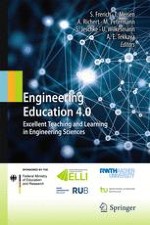2016 | OriginalPaper | Chapter
Chances and Risks of Using Clicker Software in XL Engineering Classes – From Theory to Practice
Authors : Valerie Stehling, Ursula Bach, René Vossen, Sabina Jeschke
Published in: Engineering Education 4.0
Publisher: Springer International Publishing
Activate our intelligent search to find suitable subject content or patents.
Select sections of text to find matching patents with Artificial Intelligence. powered by
Select sections of text to find additional relevant content using AI-assisted search. powered by
